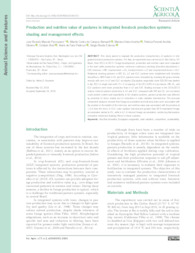Production and nutritive value of pastures in integrated livestock production systems: shading and management effects.
Production and nutritive value of pastures in integrated livestock production systems: shading and management effects.
Author(s): PEZZOPANE, J. R. M.; BERNARDI, A. C. de C.; AZENHA, M. V.; OLIVEIRA, P. P. A.; BOSI, C.; PEDROSO, A. de F.; ESTEVES, S. N.
Summary: This study aimed to evaluate the production characteristics of pastures in integrated livestock production systems. For that, an experiment was carried out in São Carlos, SP, Brazil, from 2013 to 2015. Forage development, production and nutritive value were evaluated in five beef cattle production systems: extensive continuous stocking (Urochloa decumbens) = EXT; intensive = INT; crop-livestock = iCL; livestock-forest = iLF and crop-livestock-forest = iCLF. Rotational stocking pastures in INT, iCL, iLF and iCLF systems were established with Urochloa brizantha cv. BRS Piatã. In iCL and iCLF, pastures were renovated by resowing the grass simultaneously with corn. In iLF and iCLF, eucalyptus (Eucalyptus urograndis clone GG100) was planted in Apr 2011 in single rows with 15 × 2 m spacing. In the 2013/2014 crop season, INT, iCL, and iCLF pastures were more productive than in iLF and EXT. Shading increase in the 2014/2015 season reduced pasture production in iLF and iCLF, compared with INT and iCL, but increased crude protein content and digestibility. In the shaded systems, pasture production was affected by proximity to trees, mainly due to reductions in solar radiation transmission. The principal component analyses showed that forage accumulation and leaf area index were associated with the position in the middle of the inter-row, and nutritive value was associated with the position at 1.5 m from the trees. In iCLF, solar radiation transmission greater than 60 % maintained forage accumulation similar to iCL, while in iLF, it reduced forage accumulation, evidencing that pasture renovation minimized shading effects in these systems.
Publication year: 2020
Types of publication: Journal article
Observation
Some of Embrapa's publications are published as ePub files. To read them, use or download one of the following free software options to your computer or mobile device. Android: Google Play Books; IOS: iBooks; Windows and Linux: Calibre.
Access other publications
Access the Agricultural Research Database (BDPA) to consult Embrapa's full library collection and records.
Visit Embrapa Bookstore to purchase books and other publications sold by Embrapa.

